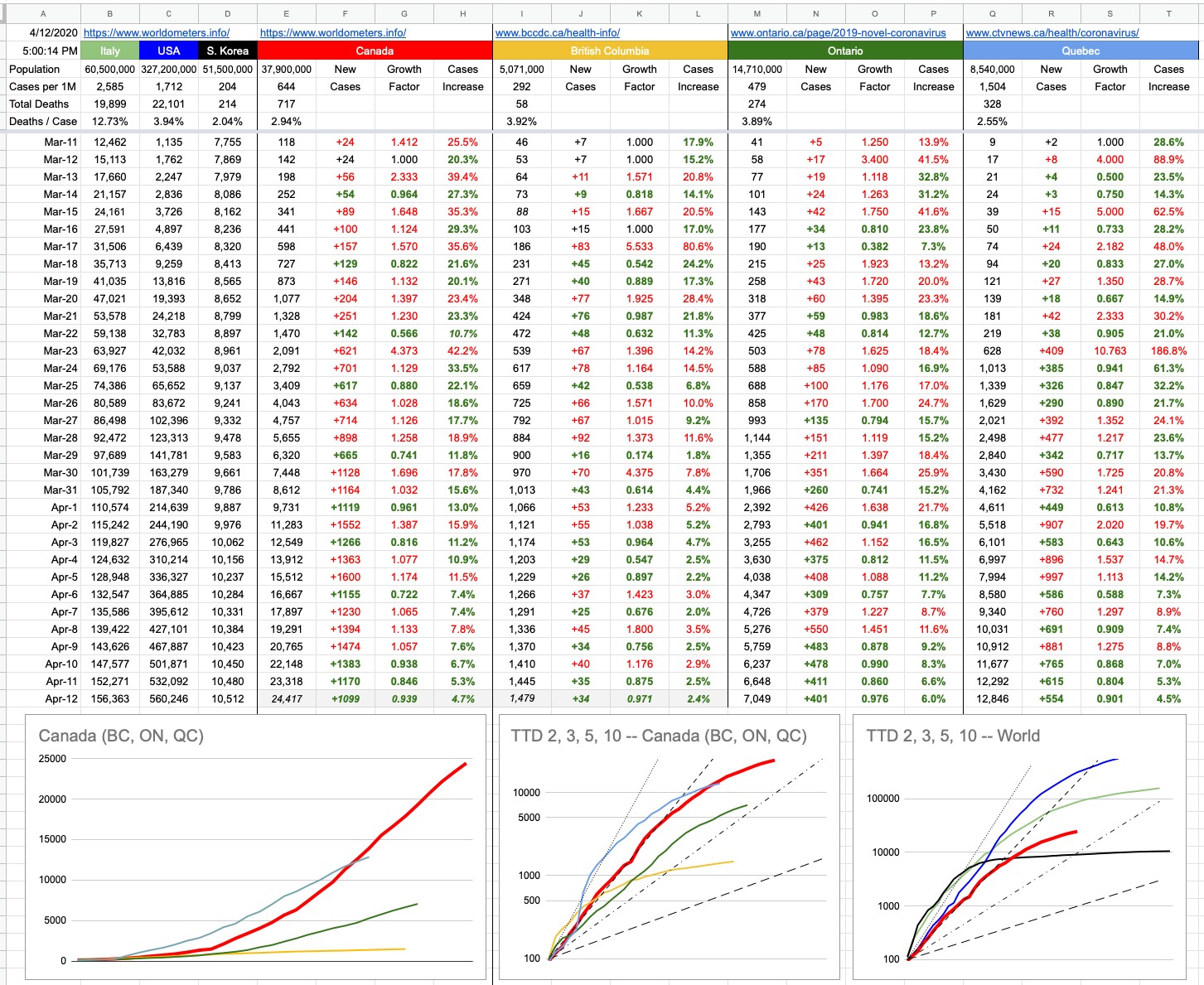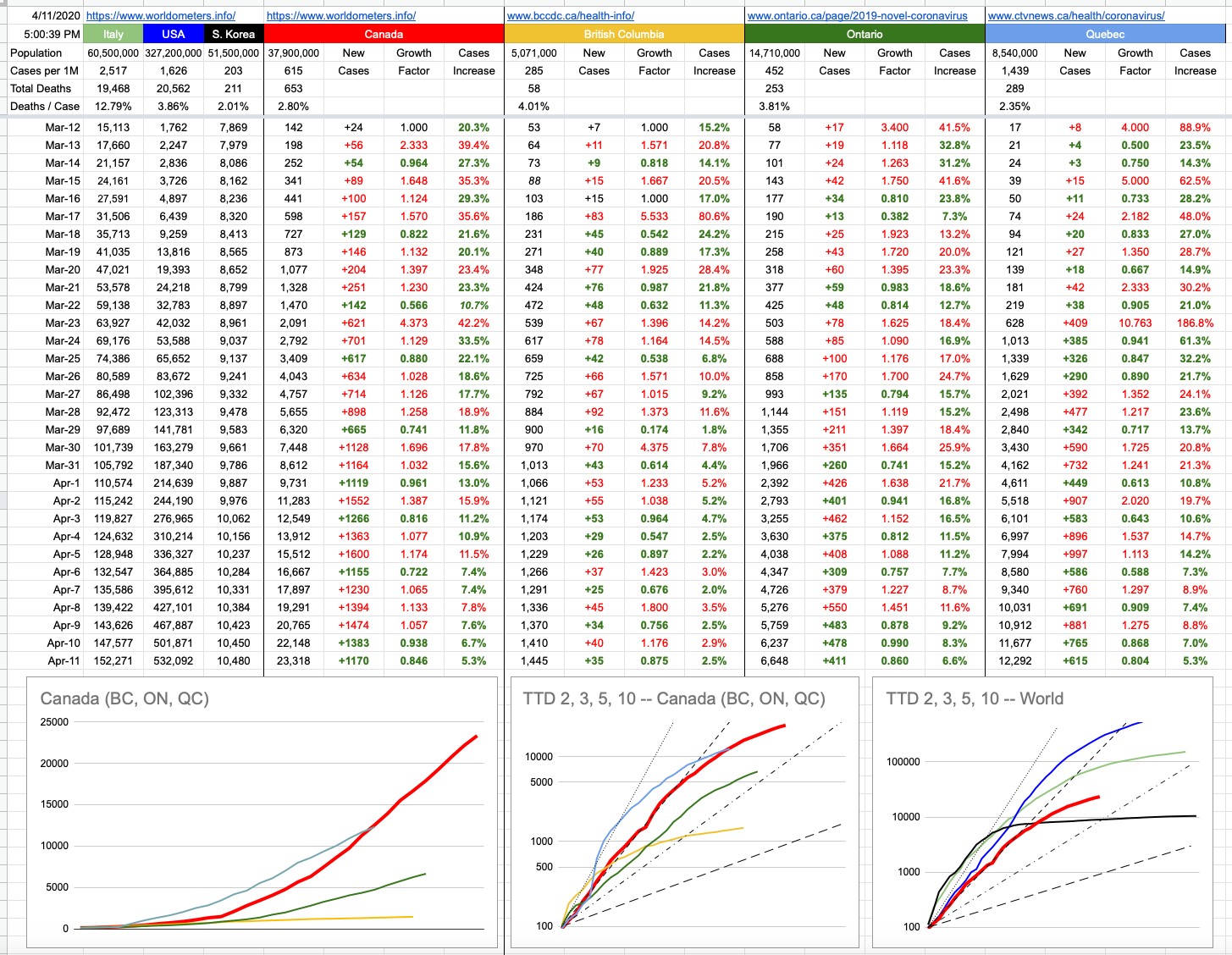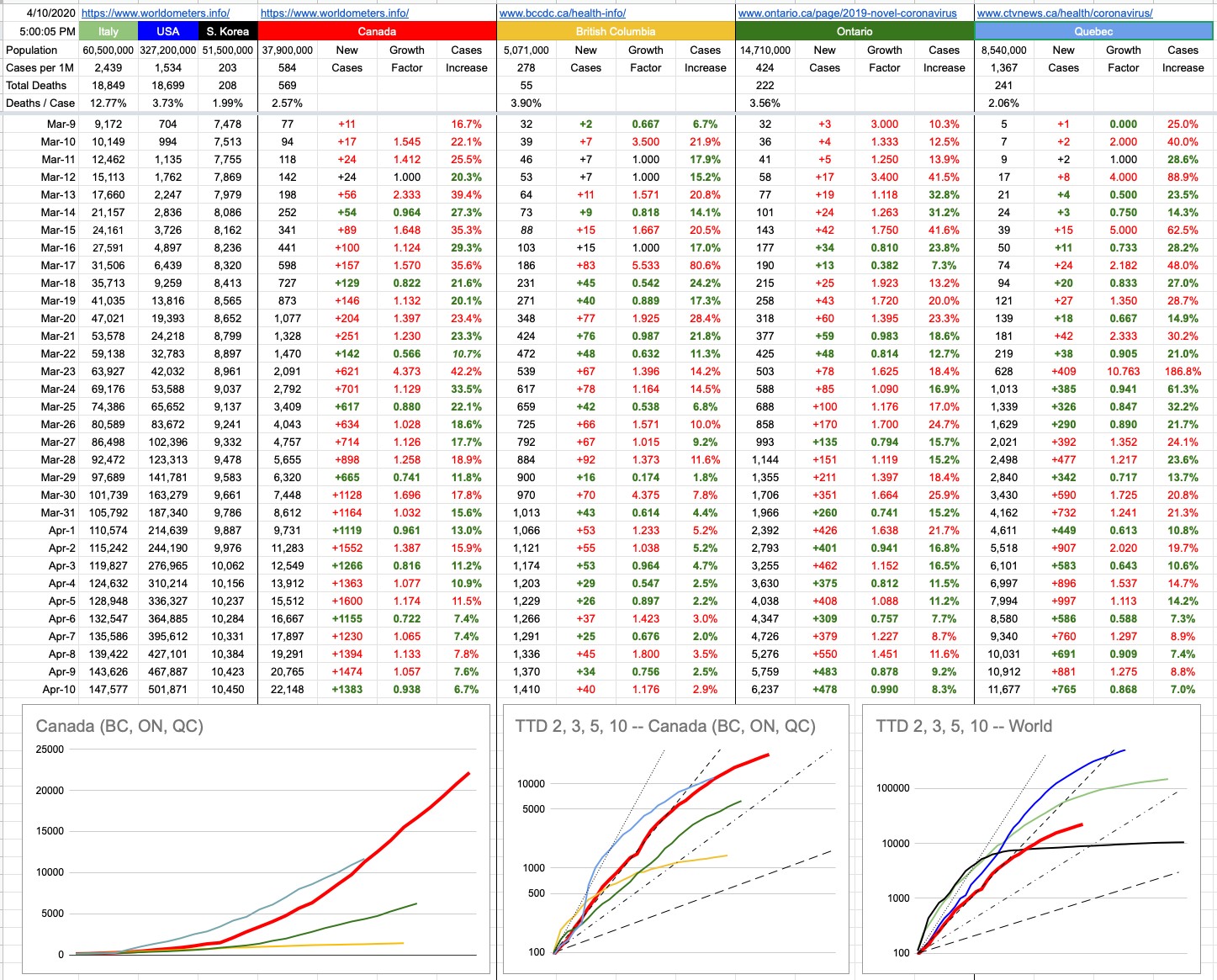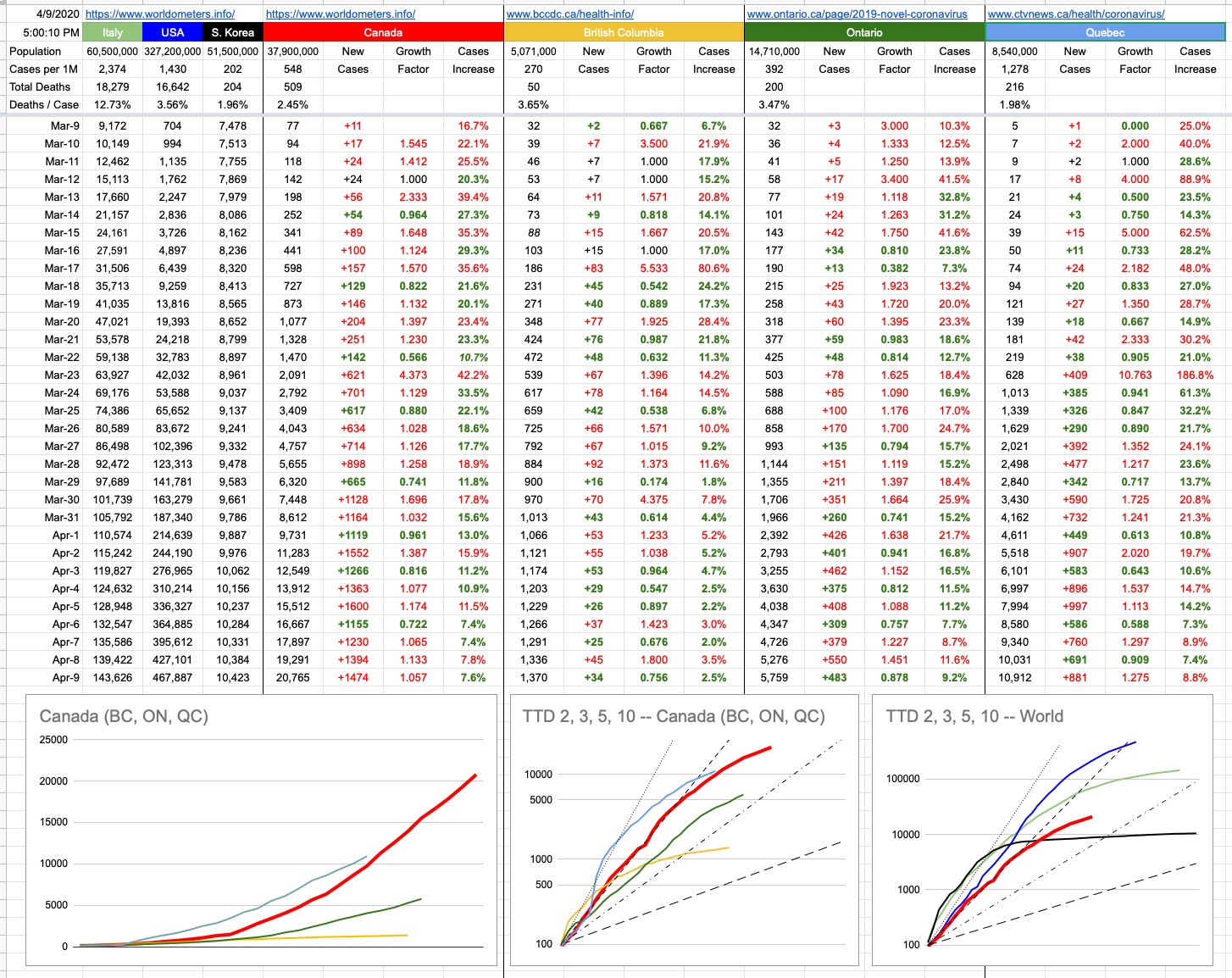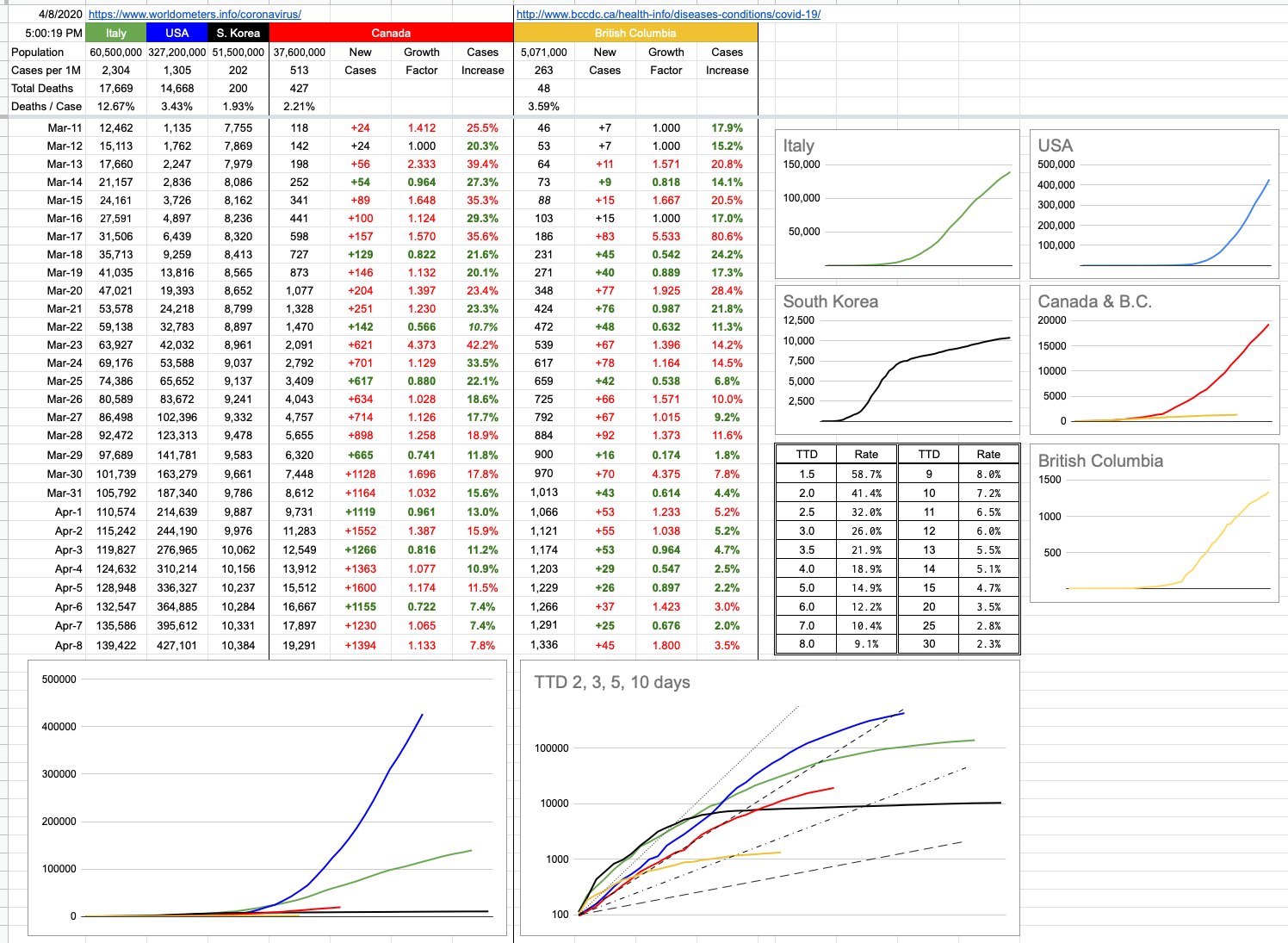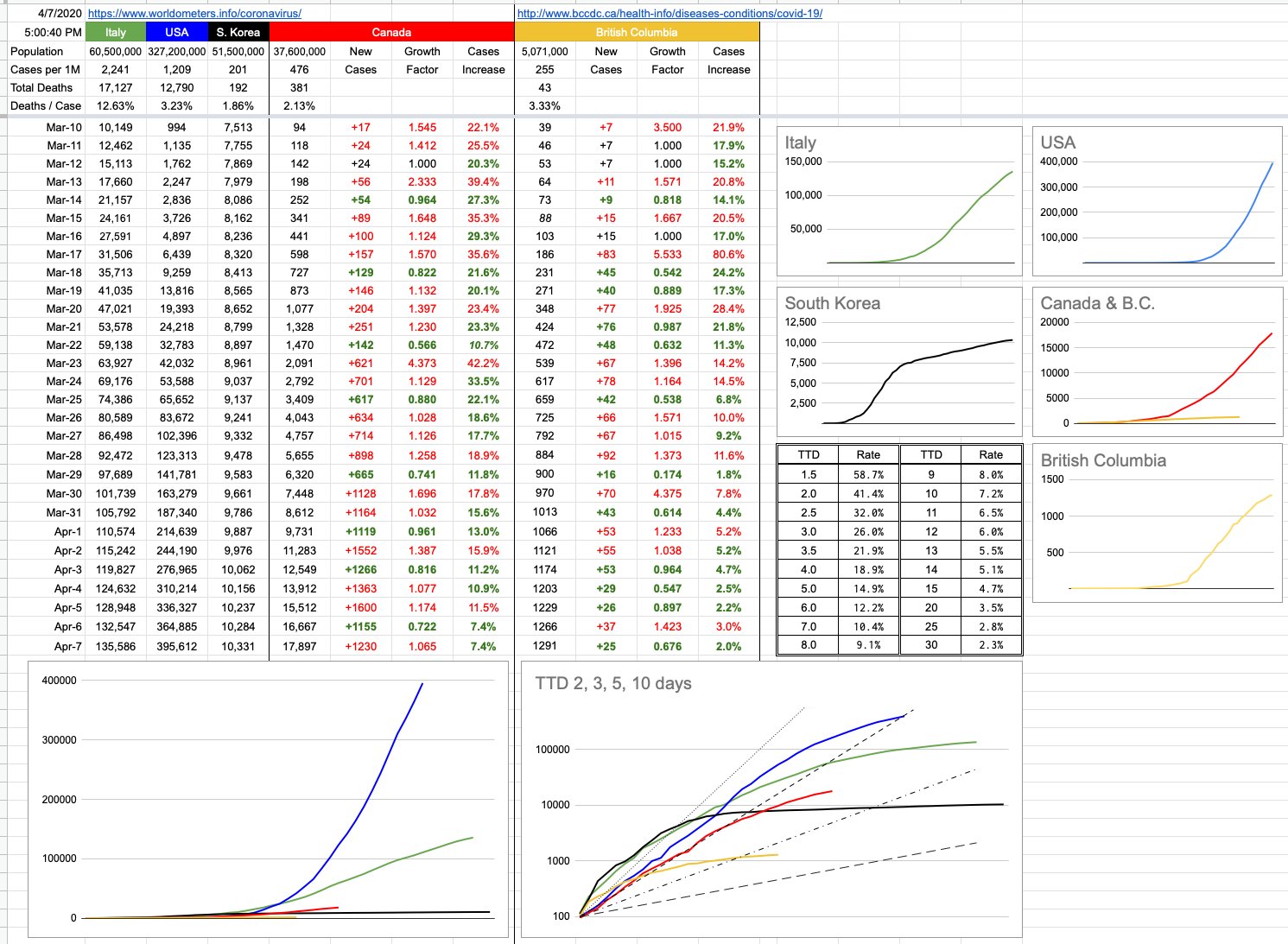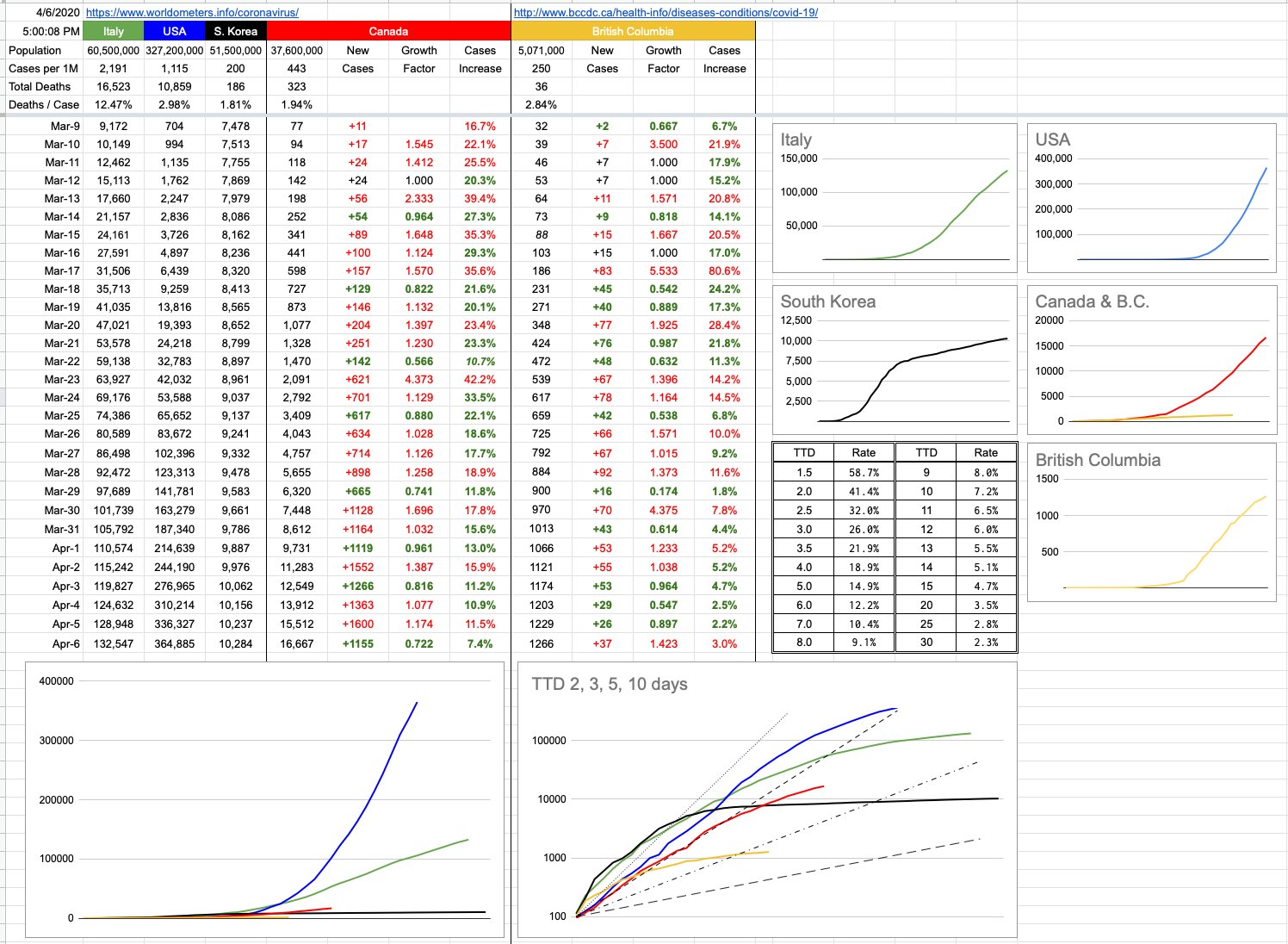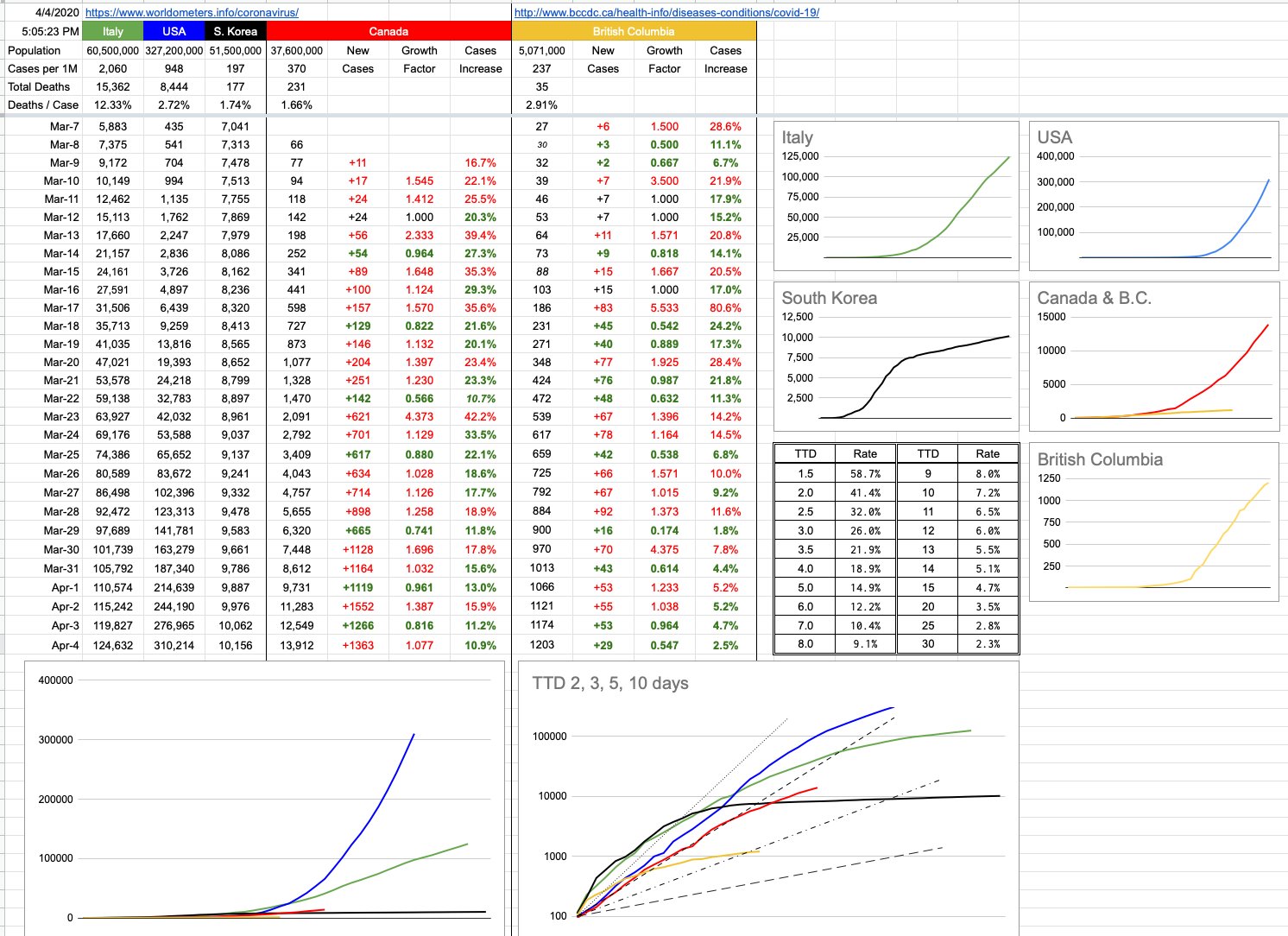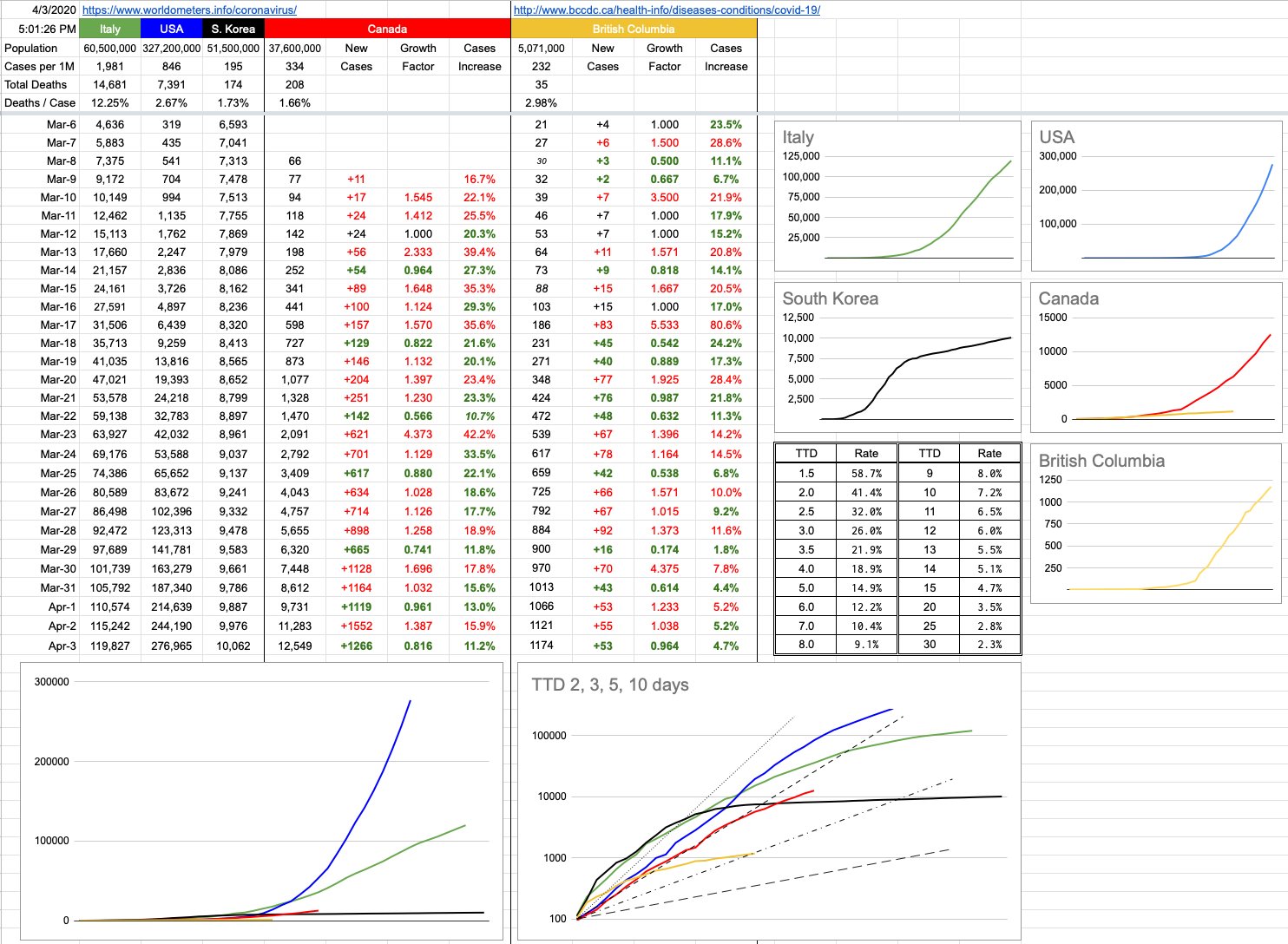Day 27 – April 12, 2020
Today is the day we don’t get numbers in B.C. — Dr. Henry and Mr. Dix are taking a well-deserved break, so accurate numbers will have to wait till tomorrow. For now, as usual, I’ve plugged in my B.C. guess for the day — I’ll fix it tomorrow. But assuming a good day locally, it’d make it a good day nationally. Growth rate was down in Ontario for a 4th straight day, and 3 straight days in Quebec.
But while they’re resting, and the numbers people are resting… as many of you are as well… let’s look at things from a much bigger-picture point of view. Like, these days, the earth is also resting.
If you were to believe that the earth is in some way alive and/or conscious, you’d be making the interesting parallel these days that, as a living being, Gaia finally got sick and tired of the virus infesting Her and decided to vaccinate Herself. For the most part, the young people who had nothing to do with wrecking the place would be spared… but the older you are, the more responsible you are for the disregard and destruction and pollution and reckless abandon that have finally made Mother Earth say “Enough”.
Gaia doesn’t have to wipe us all out to heal Herself. She just needs to give us a bit of a wake-up-call, and not much of one as it turns out.
In the grand scheme of things, it’s interesting to note just how irrelevant humanity is to this planet. In a matter of mere weeks, there are changes occurring. The sky is more blue. The water is cleaner. The air is undoubtedly less polluted. People in Punjab can see the Himalayas. People in L.A. can see the Hollywood sign. If there was ever a sign that a little change can make a big difference, there you go. And for all of us thinking we’re wrecking the planet, we are… without a doubt. But if you think this planet can’t fix itself once humanity is gone, that’d be wrong. It can and it will, very easily. Our time on this earth is so irrelevant in Her own grand scheme of things, that… well, let’s explore it. Let’s start by talking about big numbers.
Let’s say you walk out of the bank with $1,000 in cash. It’s a collection of different bills… you’re not sure exactly how many hundreds or fifties or twenties, but it adds up. The teller counted it out in front of you. There’s a Starbucks next to the bank, so you pop in there and get that Pumpkin Spice Latte you’ve been craving. Yes, certainly by October, you’ll be doing this.
The PSL costs… whatever, you’re not paying attention. You give the barista a ten dollar bill and get back a handful of change… some Toonies and Loonies and whatever else, which you jam into your pocket. If someone at that point had asked you how much money you have on you, your answer would be “Around $1,000”. On your way out of Starbucks, there’s a homeless guy there. You fish into your pocket and give him a Toonie. How much do you have on you now? “Around $1,000” is still accurate.
You walk a block and there’s a shiny Loonie sitting on the sidewalk. Quick Karma repayment! You pick it up and put it in your pocket. How much do you have now? Yes, around $1,000… and if you hadn’t picked up that Loonie, the answer would still be the same… around $1,000. That Loonie is little more than a round-off error in your present grand scheme of things of how much you have on you. And that $1,000 is similarly related to a million dollars. If you have around a million dollars, adding or subtracting a thousand doesn’t change anything. It’s still around a million dollars.
I mention all that to create some context and scale between a number we’re all familiar with… a thousand is relatable in many ways. A million less so… we know it’s a lot bigger, but sometimes we don’t realize just how much bigger. And to keep going, when we hear about a billion, we maybe don’t quite realize how big that is. A million is pretty irrelevant when you’re taking about a billion. A million seconds is less than 12 days. A billion seconds is close to 32 years. Indeed, 3 million heartbeats is a few days. 3 billion is your entire life.
Let’s pretend we map out the age of the earth (4.5 billion years) as a long road — the Trans-Canada highway. And let’s walk it. We’ll start at Mile 0 in Victoria — a charming little park at the foot of Douglas St. There are some stairs down to the beach… those would’ve been Terry Fox’s last steps before dipping his artificial leg into the Pacific Ocean, had he completed his Marathon of Hope. Today is the 40th anniversary of the start of his heroic effort, so we’ll begin our walk down there, one foot in the water on our long journey to St. John’s. Each step to the east is one step back in time.
At this scale, each step is 5,800 years. One step out of the water and that’s pretty much all of recorded human history. In fact, by the time you hit the monument at the top of the stairs, that’s about 600,000 years. Humans haven’t been around that long. And we’re still really at Mile 0. The era of humanity is barely a rounding error, as far as the age of the earth is concerned.
Keep walking east, going back in time as you do… dinosaurs died out somewhere near Abbotsford… and only appeared somewhere near Kamloops. Mammals appeared somewhere around Cache Creek. And right around Golden, before you even set foot in Alberta, now we’re at 540 million years ago… that was the emergence of anything more complicated than single-celled life forms. And beyond that, there is a lot more time and distance. It’s all single-celled organisms until somewhere in central Quebec, and then, there ceases to be any life at all. Quite a journey. Canada is a big place. 4.5 billion years is a long time.
The point of all this… as much of a blip in the radar as humanity might be, and as much as the thought of Gaia being this living/breathing thing that Herself is sick… we fight off sickness by being healthier; by allowing our bodies to heal. By giving them the opportunity to do so. A vaccine doesn’t cure you; it allows your body to cure itself. A ventilator allows you to breathe, and it’s the processes beneath that, carrying oxygen-rich blood to your cells… which heal you. Anything that stirs your immune system into action, whether physical or just mental (placebos work for good reason).
So while the earth has temporarily kicked us all into a state of self-reflection and healing, we can see that it doesn’t take much to heal the bigger picture… and it also gives us an opportunity to find some sliver linings to this big cloud, because there are many. I’m as anxious to get back to the real world as you are, but already I can see some changes I’ll make going forward, and I’m sure many of you have as well. We’ve all been learning a lot about ourselves and our habits and what’s important and what isn’t.
I leave you with this… written by Kitty O’Meara, which will read like a prayer for those who are religious, and a like a poem for those who are not. Either way, beautiful words that make you think as you stare out at the sky on this beautiful day… whether out the window or from your balcony or porch or back yard… and yeah, the sky does look more blue, doesn’t it?
And the people stayed home.
And read books, and listened, and rested,
and exercised, and made art, and played games,
and learned new ways of being, and were still.
And listened more deeply.
Some meditated, some prayed, some danced. Some met their shadows.
And the people began to think differently.
And the people healed.
And, in the absence of people living in ignorant, dangerous, mindless, and heartless ways, the earth began to heal.
And when the danger passed, and the people joined together again, they grieved their losses, and made new choices, and dreamed new images, and created new ways to live and heal the earth fully, as they had been healed.
View Original Post and All Comments on Facebook


